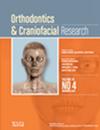The coordination of bimaxillary alveolar arch widths in subjects with normal occlusion or posterior crossbite: A CBCT retrospective study
Abstract
Objectives
To propose a method for evaluating the coordination of maxillomandibular alveolar arch in transverse dimension with cone-beam computed tomography (CBCT) and to apply this method to subjects with normal occlusion at different dentition stages or transverse discrepancy.
Materials and Methods
Digital data of 130 patients with normal occlusion at different dentition stages or transverse discrepancy were collected for three-dimensional reconstruction. The patients with normal occlusion were divided into Group 1 (>16 years) and Group 2 (≤16 years) based on their age. Adult patients with posterior crossbite were divided into the Group 3. According to the proposed method, the average alveolar arch coordination angle (AACA) and other parameters were analysed in each group. Group 1 was considered as the control group and compared with Group 2 and Group 3.
Results
Significant differences were observed in the maxillary posterior segment width among patients with normal occlusion. Group 3 demonstrated increased AACA and mandibular alveolar arch width compared with the normal occlusion group. Pearson correlation analysis indicated a positive relationship between maxillomandibular alveolar arch widths in the normal occlusion groups, with a strong correlation between AACA and the disparity in maxillomandibular widths.
Conclusion
Adults with normal occlusion exhibit significantly wider maxillary posterior alveolar arches than adolescents, with no marked difference in mandibular widths. The posterior crossbite group showed broader mandibular alveolar arches. There was a strong correlation between AACA and the difference in maxillomandibular widths. This study's method shows potential value for orthodontic transverse diagnosis.

 求助内容:
求助内容: 应助结果提醒方式:
应助结果提醒方式:


